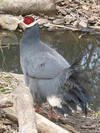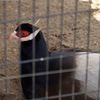Genus Crossoptilon

Blue Eared-Pheasant - The Blue Eared Pheasant is found throughout mountain forests of central China. The diet consists mainly of berries and vegetable matters.
White eared pheasant - White Eared Pheasants are called Shagga by indigenous Himalayan peoples. Shagga means Snow Fowl. Shagga are very gregarious birds, living in large flocks which forage on alpine meadow close to or above the snowline throughout the year. White Eared pheasants tend to fly a great deal more than their close relatives the brown eared and blue eared pheasants. All three ecological species are obliged to hover or volplane over deep snow. They do this with the aid of their great wide tails. Eared pheasants move across deep snow by whirring their wings and fluttering close to the ground, and supporting their weight on their retrices, leave characteristic if somewhat other worldly appearing tracks. Eared pheasant flight is often described as poor by the hunter collectors of the 18th century who used dogs to beat the birds from the ground for shooting. Eared Pheasants do not waste their energy on flying when quadrupeds take after them because they have adapted many defensive escape behaviors that do not require flight.
Tibetan Eared-Pheasant - Its natural habitats are boreal forests and temperate forests. It is threatened by habitat loss.
Brown-eared Pheasant - The rarest member in the genus Crossoptilon, its diet consists mainly of roots, bulbs and plant matters. The female lays five to eight large eggs. The eggs are pale stone green in color and take 28 days to hatch.



